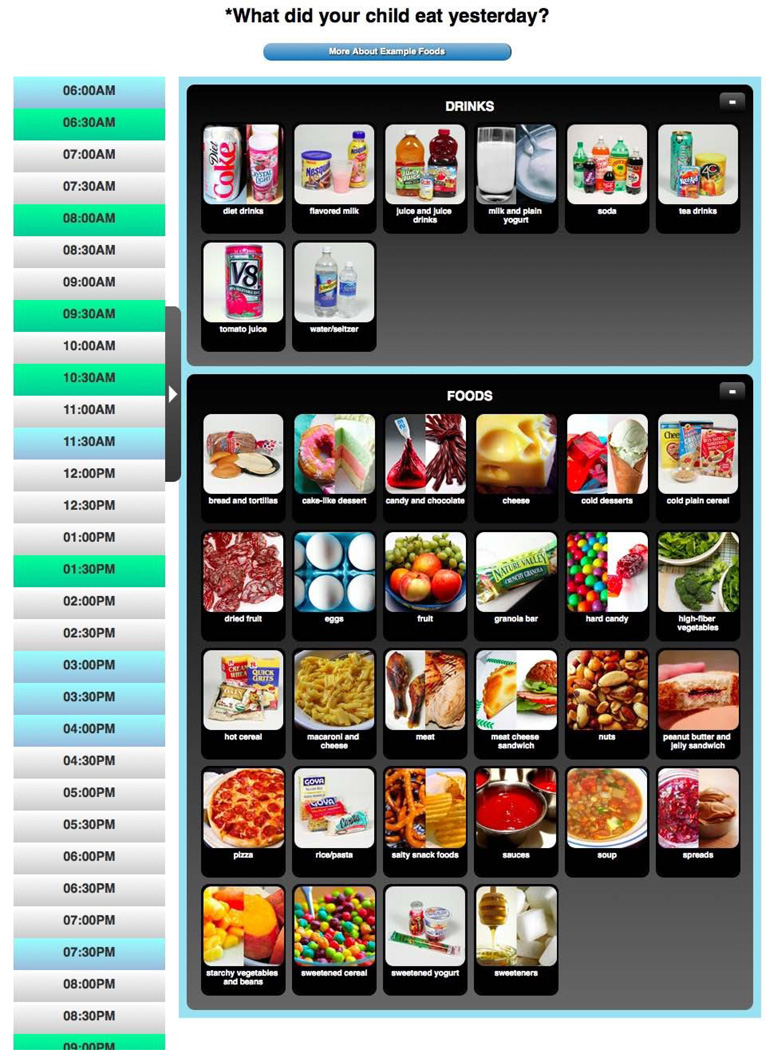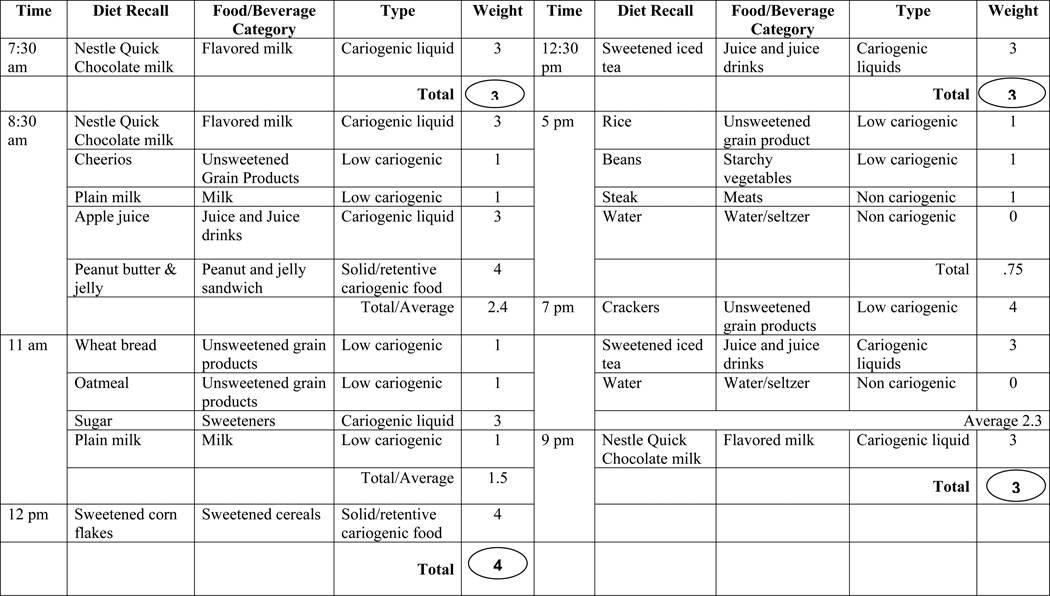Background
Early childhood caries (ECC), defined as the occurrence of tooth decay in children less than six years of age, is a chronic, highly prevalent1 and consequential2 disease of US children that is overwhelmingly diet dependent. 3 Although ECC is a multi-factorial disease that is only partially explained by sugar intake,4 the importance of diet has long been well established through laboratory, clinical, and epidemiological studies.5 This knowledge has been translated into dietary recommendations for the prevention or suppression of caries activity in young children, 3 often with only limited success.6
In an effort to reduce ECC prevalence and its consequences in a high-risk, economically-stressed Latino population in Northern Manhattan, New York City, a multidisciplinary team of Columbia University researchers—including experts from behavioral nutrition, pediatric medicine and dentistry, community health, social work, and information technology—has developed MySmileBuddy (MSB), a prototype web-based application for the iPad (Apple, Inc, Cupertino, CA) that facilitates community health workers’ (CHW) engagement of parents in dental caries prevention with funding support from the National Institute on Minority Health and Health Disparities (1RC1MD004257-01). The prototype was designed for the iPad but can be used by CHWs with parents on any laptop, desktop, tablet, or smart phone because this program operates in common web browsers. Central to its utility is its diet recall function (Figure 1), a subprogram designed to engage families in a modified 24 hour recall that contributes to a risk score for individual children. This paper describes the challenges confronted and approaches adopted in designing this diet recall function for initial dietary screening by non-professional peer counselors.
Figure 1.
MySmileBuddy Dietary Recall Funcion Tool
Engagement of Community Health Workers
ECC disproportionately impacts families that are disadvantaged by low-income, low-literacy, cultural barriers, and minority status. Lay health workers, including community health workers and Head Start Health Workers, are often on the front lines counseling such families. Needed for caries prevention is an approach that engages such lay personnel in completing an initial dietary screening assessment, not intended to be a thorough recall assessment, but sufficient to inform MSB’s underlying caries risk algorithm. Twenty-four hour recalls have been identified as an interviewer-administered tool to assess diet for caries risk in adults 7, 8 and children. 9 The automated diet recall function serves to guide the CHW through such an assessment.
Dietary caries risk assessment
The current American Academy of Pediatric Dentistry Guideline on caries-risk assessment identifies dietary risk for caries through only two factors: the number of reported between meal sugar-containing snacks or beverages and sugar containing bottle exposures.10 The challenge was to develop a recall methodology that reflected knowledge of dietary cariogenicity while also being suitable for use by lay health workers.
Dietary cariogenicity is predicated on the frequency, duration, and timing of simple carbohydrate exposure rather than the quantity of sugar consumed as these factors contribute to the total time that acidogenic bacteria in the dental plaque have substrate available to them for acid production. Foods consumed in combination may also be less cariogenic than sugar-containing foods consumed in isolation.11 To account for these complexities, a food grouping system was used and scoring method developed at the Tufts University School of Dental Medicine which incorporates timing, physical form, and retention characteristics.9
Each of several food and beverage categories developed for MSB were assigned weights from zero to four based on progressive degrees of assumed cariogenicity.9 For each eating and drinking occurrence (meal or snack), weights for each consumed item or items are averaged. If the weighted value for an eating occurrence is scored as three or greater, it is considered a cariogenic occasion. The number of “risky” occasions are then summed for the day and given a total weight (Figure 2) which contributes to a child’s dietary risk score. In addition to the dietary risk score, additional elements contribute to the algorithm to produce an overall caries risk score which include fluoride exposures (ex. type of toothpaste used), family history (ex. parental experience with tooth decay), feeding practices (ex. sippy cup use), and thoughts and feelings about oral health (ex. confidence in reducing tooth decay).
Figure 2.
Example of a MySmileBuddy Dietary Recall Functiona
aWeighting method of sample dietary recall function from four year old Hispanic girl. Circled weights indicate a “risky” eating occurrence with an average weight ≥ 3 for that eating occasion. There are four total “risky” occurences for the day.
Adaptation to the target population
Food and beverage categories were developed in collaboration with mothers of young children in the local target community through focus groups. Pictures of foods from proposed categories (e.g. beverages, snack items, desserts) were shown to participants who were asked to assess whether the photos captured their children’s feeding practices. This exercise resulted in 25 food and seven beverage categories that represent the typical diets of this population.
Foods and beverages from neighborhood bodegas were photographed to represent items in each of the categories. To conduct the recall, the CHW asks the parent if the prior day was a typical eating day and, if so, what their child ate and drank. As the parent recalls each food occurrence for their child, the appropriate category is selected on the iPad (Figure 1). A detailed listing of specific foods within each category is available for reference to assist in identifying the appropriate category (e.g. cake like dessert category includes cakes, cookies, pies, doughnuts, muffins, and sweat breads). As the parent recalls the items consumed, the CHW presses the picture/pictures of the food/drink consumed during that eating occurrence and draws the photo(s) onto the timeline which is proffered in 30 minute intervals. Unlike a more classical recall, information on portion sizes is not collected as it would substantially increase respondent burden while not adding to the caries risk calculation.12
Delivery and testing of research
The purpose of the diet recall function is to inform caries risk rather than to assess overall diet quality. Once a child’s caries risk level is determined by combining information on diet with other factors, the software offers the parent a list of behavioral goals to choose among and the opportunity to develop an individualized action plan that can meet the selected goal. When deployed in the community, the CHW will revisit the parent to assess progress in meeting the selected goal and to offer assistance in achieving caries control.
A small pilot test was conducted within the Community Health Worker Program at the Northern Manhattan Perinatal Partnership Program, a case management program that provides health and family support to pregnant women and parents of children under one year old. This study was overseen by the Columbia University Medical Center Institutional Review Board (IRB human subjects protocol number AAAE5799). Members of the project development team engaged six Northern Manhattan Perinatal Partnership CHWs (four CHWs and two CHW interns) in two training sessions, two weeks apart, lasting two-hours each. In the first session, CHWs were provided with an overview of ECC, viewed a demonstration of MSB, and were given an instructional guide along with two project funded iPads. They were encouraged to gain familiarity through practice with the iPads and the program. Following this two-week experiential learning period, a second training session was convened for them to discuss their experience and role-play with the trainers. After facilitating MSB with 35 primarily Latina mothers, the CHWs were asked to complete an anonymous survey reporting on usability and usefulness of the program. Based on five point Likert Scales, the CHWs provided high scores for “ease of navigation” and “usefulness in educating families” with mean responses of 1.75 (one equal to very easy and very useful and five equal to not easy at all and not useful at all). They also commented that the technology was “fun and easy for families” and “enjoyable in a visual way.” The development of the MSB program will continue including validation of the diet recall function’s contribution to caries risk along with expanding the planning and follow up component of the program.
Conclusions
Current research shows that capturing food intakes from one typical day identifies significant associations between diet and presence of severe caries developed in early childhood.9 By creating a mobile application that features an interactive diet recall function, the task of assessing diet for caries risk is assisted by the technology and delivered by lay personnel. With further research, the use of mobile technology for dietary assessment identified in this project may be applicable for widespread use in a variety of sites and programs that address the health needs of young children.
Acknowledgments
Funding Source: 1 RC MD 004257-01 (PI: B. Edelstein)
Footnotes
Publisher's Disclaimer: This is a PDF file of an unedited manuscript that has been accepted for publication. As a service to our customers we are providing this early version of the manuscript. The manuscript will undergo copyediting, typesetting, and review of the resulting proof before it is published in its final citable form. Please note that during the production process errors may be discovered which could affect the content, and all legal disclaimers that apply to the journal pertain.
References
- 1.Edelstein BL, Chinn CH. Berg J, Slayton R. Early Childhood Oral Health. Ames, IA: Blackwell Publishing; 2009. Definition and Epidemiology of Early Childhood Caries; pp. 18–49. [Google Scholar]
- 2.Casamassimo PS, Thikkurissy S, Edelstein BL, Maiorini E. Beyond the dmft: The Human and economic Cost of Early Childhood Caries. J Am Dent Assoc. 2009;140:650–657. doi: 10.14219/jada.archive.2009.0250. [DOI] [PubMed] [Google Scholar]
- 3.Tinanoff N, Palmer CA. Dietary determinants of dental caries and dietary recommendations for preschool children. J Public Health Dent. 2000;60:197–206. doi: 10.1111/j.1752-7325.2000.tb03328.x. [DOI] [PubMed] [Google Scholar]
- 4.Marshall TA, Elchenberger-Gilmore JM, Broffitt BA, Warren JJ, Levy SM. Dental caries and childhood obesity: roles of diet and socioeconomic status. Community Dent Oral Epidemiol. 2007;35:449–458. doi: 10.1111/j.1600-0528.2006.00353.x. [DOI] [PubMed] [Google Scholar]
- 5.Tinanoff N. Association of diet with dental caries in preschool children. Dent Clin North Am. 2005;49:725–737. doi: 10.1016/j.cden.2005.05.011. [DOI] [PubMed] [Google Scholar]
- 6.Ismail AI. Prevention of early childhood caries. Community Dent Oral Epidemiol. 1998;26(Suppl 1):49–61. doi: 10.1111/j.1600-0528.1998.tb02094.x. [DOI] [PubMed] [Google Scholar]
- 7.Marshall T. Chairside Diet Assessment of Caries Risk. J Am Dent Assoc. 2009;140:670–673. doi: 10.14219/jada.archive.2009.0252. [DOI] [PubMed] [Google Scholar]
- 8.Mobley C, Dounis G. Evaluating Dietary Intake in Dental Practices: Doing It Right. J Am Dent Assoc. 2010;141:1236–1241. doi: 10.14219/jada.archive.2010.0051. [DOI] [PubMed] [Google Scholar]
- 9.Palmer CA, Kent R, Loo CY, et al. Diet and Caries- associated Bacteria in Severe Early Childhood Caries. J Dent Res. 2010;89(11):1224–1229. doi: 10.1177/0022034510376543. [DOI] [PMC free article] [PubMed] [Google Scholar]
- 10.American Academy of Pediatric Dentistry Council on Clinical Affairs. Guideline on Caries-risk Assessment and Management for Infants, Children, and Adolescents. Pediatr Dent. 2011/2012;33(6):110–117. Reference Manual. [Google Scholar]
- 11.Touger-Decker R, van Loveren C. Sugars and dental caries. Am J Clin Nutr. 2003;78:881S–892S. doi: 10.1093/ajcn/78.4.881S. [DOI] [PubMed] [Google Scholar]
- 12.Palmer C. Important Relationships Between Diet, Nutrition and Oral Health. Nutr Clin Care. 2001 Jan-Feb;4(1):1–14. [Google Scholar]




